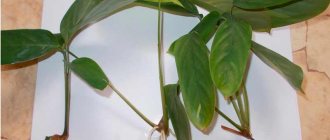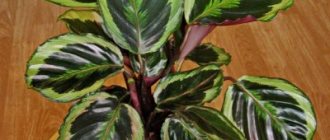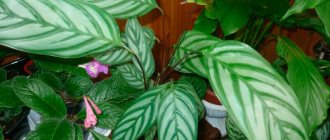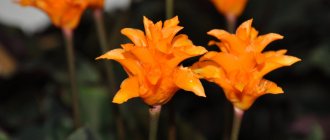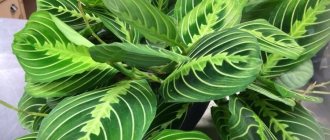Author: Elena N. https://floristics.info/ru/index.php?option=com_contact&view=contact&id=19 Category: Houseplants Published: January 30, 2019Last edits: January 11, 2021
- Dividing the bush
- Calathea leaves are drying up
- Calathea bachemiana
The Spanish conquistadors brought this South American plant to Europe from their campaigns. Calathea, like its relative arrowroot, has gained wide popularity thanks to its incredibly beautiful patterned leaves, reminiscent of the colors of the plumage of strange birds.
A healthy and well-groomed calathea will not only decorate your home, but will also be able to neutralize aggressive energy in it and bring harmony to your home.
- What types and varieties of calathea are grown indoors?
- What conditions are necessary for Calathea?
- How should you care for this tropical plant?
- How does calathea reproduce?
You will find answers to these and other questions in our article.
Planting and caring for calathea
- Flowering: most species are grown as decorative foliage plants; Varshevich's calathea and saffron bloom in January-February.
- Lighting: light partial shade.
- Temperature: normal for residential premises, but not lower than 16 ˚C.
- Watering: abundant during the growing season, moderate in winter.
- Air humidity: 90%: it is recommended to regularly spray the leaves with a fine spray or keep the calathea on a tray with damp pebbles.
- Fertilizing: from April to August twice a month with complex fertilizers for decorative deciduous plants.
- Dormant period: not clearly expressed, approximately from September to January.
- Transplantation: young plants are replanted annually, adults - once every 2-3 years.
- Reproduction: by dividing the bush, cuttings and seeds.
- Pests: thrips, scale insects, spider mites.
- Diseases: rhizoctonia, loss of decorativeness of leaves due to improper care.
Read more about growing calathea below.
plant (lat. Calathea) represents the most numerous genus of the Marantaceae family, numbering up to 130 species, which naturally grow in Central and South America. The name of the genus comes from the ancient Greek word Kalathos, which means “basket”: baskets were actually woven from the leaves of Kalathas. But today, calathea flowers do not have a utilitarian value at all, but rather an aesthetic one, since the colorful and incredibly attractive beauty of the foliage of these plants fascinates not only amateurs, but also seasoned professionals. However, only experienced flower growers can care for the Calathea flower, because it is incredibly capricious and requires a lot of attention.
- Stephanotis: cultivation and difficulties
Features of cultivation
The main feature of calatheas is their unusual leaves, but there are other properties and distinctive features that you need to know about if you are going to care for your homemade calathea. In most plant species, underground shoots form a superficial root system, from which rosettes of large oval leaves up to 30-40 cm long grow on long petioles. The height of a calathea flower can reach 70-90 cm. The flowering of calathea is unattractive, with the only exceptions being calathea saffron and calathea Varshevich, whose inconspicuous flowers are hidden behind bright bract leaves of cream, white, orange and pink shades.
The home flower Calathea is very demanding to care for, but there are species that are more adapted to indoor growing conditions and those that are less adapted. The first include Calathea Bachema, as well as decorated, Makoya, striped, Veicha (Vicha) and some others.
Kalati have one feature common to all arrowroots: in the evenings, the leaves of the plant fold and rise upward, like palms during prayer, and in the morning the leaves lower and open. For this reason, calathea, like arrowroot, is called the “prayer flower.”
general information
Calathea belongs to the Amaranth family . Its habitat is the tropical forests of South America, although its range is much wider - all the tropics except Australia. Amaranths grow on the African continent, in India, and in Oceania.
Plants of this family are liana-like or herbaceous. They have a very developed root system, which actively stores moisture and other nutrients. For calathea, this feature is doubly valuable, since it quickly dies in drought conditions .
Calathea is considered a perennial plant. Representatives of some varieties grow up to 1 m, sometimes more . The trunk is usually decorated with large leaves of various shades of green. Sometimes they are even silvery, and the back side is usually purple, lilac, violet.
Flower growers value calathea for its visual attractiveness, and this applies to a greater extent to its leaves. They have an interesting feature: during the day they occupy a horizontal position, exposing the surface to light, and at night they rise upward.
When folded, the plates resemble hands, which is why the plant is sometimes called a “prayer flower.”.
Calathea begins to bloom in the spring: it produces inflorescences that resemble spikelets.
Caring for calathea at home
Rules of care
The indoor calathea flower, like all tropical plants, is heat- and light-loving, but, as they say, moderation is needed in everything: if from a lack of lighting the leaves of the calathea turn pale and lose their decorative effect, then from an excess of light the leaves become brown, which also does not add to their attractiveness . Caring for calathea involves establishing a balance of all the needs of calathea and constantly maintaining this fragile balance, therefore the best place for calathea is light partial shade, where bright sun rays do not fall. The temperature regime needs to be smooth, without sudden changes, a lower limit of 16 ºC, and no drafts!
As for soil moisture, the most important thing in this matter is the quality of water. The water for irrigation should be warm (2-3 degrees warmer than the air in the room) and soft, rain or melted snow, but if this is not available, put two or three handfuls of peat wrapped in gauze in a bucket of ordinary tap water in the evening, and in the morning this Moisten the plant soil with water. Watering in the spring-summer period should be plentiful, but excess water that has leaked into the pan must be drained so that the roots are not affected by rot. In winter, watering is slightly reduced. The main principle of watering is to always keep the soil of the calathea slightly moist, but not wet.
Calathea at home, like its wild-growing relatives, needs very high air humidity, which ideally should be 90%, but since this is difficult to achieve in an ordinary house, you will have to frequently spray it with a fine spray or wipe the calathea leaves with a damp sponge. But only if you are growing a variety with smooth, hard leaves. Varieties with velvety leaves cannot be moistened by washing, so you will have to keep such specimens on a tray with wet pebbles so that the bottom of the flowerpot does not touch the water. But indoor calathea feels best in glass containers (aquariums, florariums), where high air humidity is constantly maintained.
Fertilizer
In this matter, the indoor calathea plant also requires a balance: there should be enough fertilizer, but in no case more than the plant needs. Complex fertilizers for ornamental deciduous plants are used as fertilizers once every two weeks from April to August, and calathea saffron and Varshevich are fertilized with fertilizers for ornamental flowering plants.
Transfer
Young calatheas require annual transplantation, adults – once every two to three years. Transplantation is carried out in the spring. The pot needs to be small and wide rather than deep. The soil for calathea should be slightly acidic, breathable and loose, as for other arrowroot or rhododendrons, and it is better to buy it in a specialized store. But if you want to make a soil mixture for calathea yourself, then you need to mix one part of humus, peat, leaf soil and half of calcined river sand.
How to transplant calathea? First, you need to place a thick layer of drainage material into the pot, then a layer of fresh soil, onto which you need to carefully, trying not to destroy the earthen lump and not damage the roots, transfer the calathea, and then add so much new soil on the sides so that it fills the entire space of the pot.
Calathea propagation
Dividing the bush
During the spring transplantation of the plant, you can divide its rhizome into parts so that each division has several leaves and formed roots. The cuttings are planted in pots with a diameter of 7-9 cm in arrowroot soil and kept in partial shade, in a warm and humid place - best on a tray with wet expanded clay next to a heating radiator. Calathea takes a long time to take root, but it all depends on how you care for it.
Cuttings
The above-ground cutting is very carefully separated from the mother plant, planted in moist soil and covered with film or a transparent bottle, which is not removed until the cutting takes root. It should be noted that not everyone succeeds in propagating calathea by cuttings.
Growing from seeds
This is the most difficult method, since even high-quality calathea seeds may not germinate. Sow the seeds in bowls with a mixture of leaf soil (two parts) and sand (one part) and grow at a temperature of 21-25 ºC. When a couple of leaves appear, the seedlings are dropped into boxes with the same soil mixture, and later, when they become stronger, they are planted in individual pots.
Reproduction methods and technology
Calathea is most often propagated vegetatively, that is, by dividing the bush. This is best combined with replanting, since the plant takes quite a long time to recover from damage to the root system.
Each division must have a well-developed piece of rhizome with a rosette of leaves. Planting material is planted in a loose substrate and kept at a temperature not lower than 20°C.
To make the rooting process faster, the pots can also be placed in a greenhouse. After the root system has mastered the entire volume of the pot, the plants will need to be transferred to larger containers.
Calathea can also be propagated by seeds. But this is quite long and troublesome. Mature plants with large and beautiful leaves can only be obtained in the 3rd year of cultivation.
Pests and diseases
If you have not created the required level of air humidity for your calathea, it may become a victim of spider mites, thrips or scale insects. In both cases, and in the third case, the leaves of the calathea turn yellow and fall off. How to save calathea from pest attacks? If you see a thin cobweb, a sticky coating or light spots on the leaves, take action: scale insects and thrips are destroyed by treating the leaves with a soap solution. But if this measure does not help, you will have to apply insecticide treatment, as is the case with spider mites.
- Dieffenbachia - care, photos, types
Calathea leaves are drying up
If only the tips of the leaves of a calathea dry out, the cause is insufficient air humidity. It is necessary to spray the leaves more often and move the plant onto wet pebbles. If dry spots appear on the leaves, then these may be traces of sunburn caused by spraying the leaves with too large splashes, which, remaining on the leaves, turn into magnifying glasses under the sun's rays. Why is calathea still drying? Due to insufficient watering, drafts and thrips damage.
Calathea turns yellow
If only the lower leaves of the calathea turn yellow, then this is the natural course of things: old leaves die off, new ones appear. But sometimes the calathea turns yellow not only in the lower part, and there can be at least two reasons for this: firstly, improper watering, and secondly, an overdose of fertilizers. Insufficient watering, as well as excessive or too frequent, can cause yellowing of the leaves. Between waterings, the earthen ball should dry two centimeters deep, otherwise, due to poor oxygen supply to the roots, the young roots will begin to rot and the leaves will turn yellow.
As for fertilizing, even during the period of active growth, calatheas only need half the dose recommended by fertilizer manufacturers. Calathea leaves may turn yellow when it freezes.
Calathea leaves curl
Calathea leaves dry and curl from too dry or cool air in the room or from drafts. As you can see, any calathea malaise is caused by a violation of the maintenance rules, and in order not to ask later why the calathea leaves curl or why they turn yellow and dry, it is enough to simply follow the agrotechnical conditions for this plant. Calathea is capricious, but there is nothing impossible in its demands.
Names and types
The following varieties of Kalati are grown in culture:
Calathea bachemiana
One of the most unpretentious calatas comes from Brazil. It has no stems, and the lanceolate, leathery leaves, silvery-green with a dark green pattern along the midrib, reach a length of 40 cm.
Calathea makoyana
Also Brazilian, up to 50 cm high. Its leaves are broadly oval, up to 20 cm long, up to 10 cm wide, the white, almost transparent upper side of the leaf is lined with dark green stripes, reddish spots and bright green veins.
Calathea picturata
The leaves are oblong up to 20 cm in length, the central vein and stripe along the edge are light in color, the middle is dark green.
Calathea leopardina
The plant is stemless, 40-50 cm in height, oval lanceolate leaves 10-12 cm long, 3-4 cm wide, light green with dark green elliptical spots connected by a central vein.
Calathea ornata
Native to the rainforests of Colombia. This is a low-growing plant, up to only 15 cm in height. The oval leaves are up to 20 cm long and 6 cm wide on top, yellowish-green with silver and pink lines, the underside of the leaf is purple. It has two varieties: Calathea ornata roseolineata and Calathea sanderiana.
Calathea crocata
It is distinguished by leaves that are dark green on the upper side and almost brown underneath. If you've ever seen this calathea bloom, you'll want to see it again: beautiful bright yellow, almost orange inflorescences appear in January or February, but only if you can give the plant ten hours of daylight.
Calathea warscewiczii
It is also interesting for its velvety dark green leaves with a light green pattern along the midrib on the upper side and purple on the lower side, and unusually beautiful inflorescences of cream, white or pink color.
Calathea zebrina
From the Brazilian tropics, it has elliptical leaves up to 40 cm long and 15 cm wide. The upper part of the leaf blade is dark green with feathery light green stripes, the underside has a reddish tint.
Veitch's Calathea or Wicha (Calathea veitchiana)
Reaches a height of 90 cm, the leaves are oval, up to 10 cm wide and 30 cm long, glossy, dark green with yellow-green stripes along the top of the leaf and yellow stripes along the purple background below.
- Protection from pests and bad weather when sowing cabbage in the ground
Calathea rufibarba
They are called so because of the red fluff on the petioles and the underside of the plain leaves, elongated and slightly wavy along the edge. Varieties: "Blue Grass" - leaves are green on both sides, "Wavestar" - the underside of the leaves is purple.
In addition to the listed varieties, calathea Litze, calathea orbifolia, calathea “Queen of Maui”, calathea Lubbers, calathea medallion or roseopicta, calathea remarkable or lanceolate and other species and their varieties are also grown at home.
Calathea roseopicta: plant description
Calathea medallion flower or Calathea roseopicta is a low herbaceous stemless shrub from the Marantaceae family. Its homeland is the northwestern part of Brazil - the impenetrable tropical rainforests of Peru, Ecuador and Colombia. It is there, in the shade of trees, on soil that never dries out thanks to natural mulching, that Calathea Medallion feels best.
Calathea roseopicta medallion was cultivated at the end of the 19th century. Under natural conditions, it can grow up to 80 cm, but in an apartment it rarely goes beyond 30 cm, both in height and width. Smooth glossy leaves grow on elastic long petioles and have an oval, ovoid shape with a pointed tip. In nature, Calathea medallion blooms in spike-shaped small inflorescences of white, cream, yellow, purple or orange. In cultivation, it hardly blooms, or does so very reluctantly.
The first scientific name "roseopicta" was given to this calathea because its leaves have a lot of pink and red colors. Unlike most kalatas, it is present not only on the back side of the leaf blades. Reddish or lilac-purple veins are clearly visible on their upper side. For this reason, in many varieties of the Medallion species, especially hybrid ones, the leaf plate resembles an anatomical aid, densely permeated with a branched capillary system. This pattern is clearly visible on young specimens, but fades as they grow older.
The name of this type “medallion” was originally “folk”, but over time it acquired official status. Calathea received it because of its rounded shape and original leaf pattern: each leaf plate is framed by a narrow border, darker than the main background, exactly repeating all the curves of the leaf. Thanks to it, the inner, lighter part is several tones lighter, looking like a picture in a frame or medallion. The back side of the leaves is plain, reddish or lilac-purple.
In the regions of the central zone, Calathea roseopicta is grown as a houseplant indoors or in a greenhouse.
Like most representatives of the Calathea species, the medallion, with good care at sunset, raises its leaves upward, as if “praying”. With dawn they return to their normal position, that is, they are located almost perpendicular to the petioles. This feature gave rise to numerous signs and superstitions. For the most part, they are of a positive nature: it is believed that the Calathea medallion brings good luck, prosperity and family well-being to the house.

